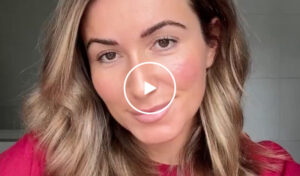You’re not alone if you’re confused by the array of cosmetic injectables with their many uses and benefits. With injectable treatments becoming ever more sophisticated – cleverly and subtly lifting, adding volume, hydrating and even encouraging skin to regenerate itself – it isn’t obvious which would best suit your skin’s needs. A qualified, experienced practitioner is always your (essential) go-to in identifying which treatment would give you, personally, best results. This quick overview will explain the main types in the meantime.
Be mindful that any ‘bad work’ you’ve seen wouldn’t be down to a specific injectable: in the hands of the right practitioner, cosmetic injectables should give you the desired subtle and natural improvement to your skin (not an overfilled, frozen look).
Starting with the newer / less-well known:
Polynucleotides
A recent launch in aesthetics (although long used in medicine), Polynucleotide treatments (PN / PDRN) are a new concept of regenerative, skin-boosting injectables, improving skin from the inside out, with immediate but also longer term benefits. They’re also a good option if you prefer treatments composed of natural ingredients.
Polynucleotides plump, hydrate and heal, are a powerful antioxidant and most importantly, activate fibroblasts – the cells which create the scaffolding and stretch in skin – delivering the ingredients needed to boost the synthesis of collagen, elastin and hyaluronic acid. In stimulating these cells, polynucleotides boost collagen production, improve elasticity and increase hydration, whilst calming inflammation and rebalancing melanocyte activity for an even and fresher skin tone.
What are polynucleotides made of?
Filtered, ultra purified and sterilised natural DNA fractions extracted from salmon or trout
Great for:
Ongoing skin improvement from a cellular level, overall skin quality, healing scars, difficult to treat areas (under eyes, mouth area)
- Lessening fine lines/
- Improving skin elasticity & texture
- Minimising pores
- Reducing under eye hollowing & dark circles
- Healing acne scarring & wounds
- Treating rosacea
- Reducing pigmentation
- Brightening skin
- Encouraging better-behaved skin
PRP (Platelet Rich Plasma)
Platelet Rich Plasma (PRP) face treatments, also known as the Vampire facial, use your own blood platelets to stimulate new cell growth, helping to improve your complexion and skin texture. An effective treatment to naturally repair and rejuvenate the skin, PRP stimulates collagen and elastin production which thickens and tightens thinning skin, thereby smoothing wrinkles and fine lines. As it boosts collagen, PRP is also a popular choice for improving overall skin texture and tone. These treatments are also particularly good for rosacea or acne.
A unique treatment which encourages growth and regeneration by harnessing your body’s natural healing ability, PRP may also help with hair loss. Whilst it may seem an unusual concept, it’s a simple procedure: blood is gently taken from the patient, spun and then the vital components are re-injected into the skin and the plasma-rich platelets release potent quantities of growth factors and proteins to stimulate a healing response.
What is PRP made from:
Platelet-rich plasma taken from your own blood (plasma, or the liquid component of blood, and platelets, blood cells that plays an important role in healing)
Great for:
A wholly natural treatment option for
- Thickens & tightening thinning skin
- Smoothing wrinkles & fine lines
- Improving overall skin texture & tone
- Treating rosacea or acne
- Boosting thinning hair
- Healing wounds & injuries
Skin Boosters
Other more recent favourites are skin boosters: an umbrella term for highly-popular treatments such as Profhilo or Redensity which primarily focus on improving skin quality and hydration. Skin boosters are typically composed of hyaluronic acid (HA) – a water-retaining molecule which although found naturally in the skin, depletes with age, and when injected can bind up to 1000 times its weight in water.
These game changers enabled doctors for the first time to inject a product which spreads and encapsulates moisture in the skin, thereby improving skin quality across a wider area, rather than just freezing or filling skin at the injection sites as injectables had done previously. Acting as ‘biostimulators’, we inject these compounds into the dermis to get to work at that deeper level, revitalising your skin. They can enhance skin radiance, elasticity and smoothness, making skin appear more youthful and refreshed.
What are skin boosters made of?
A gel-like substance, typically composing a blend of hyaluronic acid, vitamins, antioxidants, minerals and / or amino acids
Great for:
Hydrating skin from within, improving elasticity, lines, texture, dry, dull or uneven skin and overall skin quality and health
- Addressing early signs of ageing
- Deeply hydrating dull / dry skin
- Improving skin quality, laxity, tone & texture
- Defining the lower face
- Tightening skin on neck, knees or hands
- Enhancing overall skin appearance
- Boosting skin health
Dermal Fillers
Dermal fillers are used to combat signs of ageing when skin has lost elasticity and plumpness and faces therefore have less definition. Used correctly, dermal fillers add subtle volume to soft tissue in the face, in the cheeks, mouth, lips, around the eye or jawline, as well as treat dark circles and plump thinning lips. Fillers usually contain water-attracting hyaluronic acid but some contain other substances.
Dermal fillers, on the other hand, are primarily made of HA or other synthetic substances. Their purpose is to add volume, fill in wrinkles or folds, and enhance facial contours by plumping up specific areas.
Dermal fillers, on the other hand, are primarily used for volume restoration and contouring. They can effectively address deeper wrinkles, folds, and areas with lost volume due to aging or other factors. Dermal fillers provide immediate results by plumping up the targeted areas and can help achieve a more youthful and rejuvenated appearance.
What are dermal fillers made of?
Whilst most are made from hyaluronic acid (naturally found in the body), others contain ingredients such as calcium hydroxylapatite, a mineral and bone component, or Poly-L-lactic acid (PLLA), a biodegradable, synthetic material
Great for:
Restoring lost volume from ageing, plumping naturally thinner lips, generally defining the face (adding fullness, shape or contour)
- Smoothing moderate-to-severe lines, wrinkles & folds
- Adding fullness to cheeks or chin
- Plumping thinner lips
- Defining the jawline
- Firming loose skin on hands
- Correcting under-eye hollows
- Restoring facial fat loss
Anti-wrinkle / Toxin injections
Quite remarkably, given how long toxin-based injections have been available, these ‘neuromodulators’ with their muscle relaxant properties remain the most popular non-surgical cosmetic procedure worldwide. The first cosmetic injectables were toxin injections (Botulinum toxin type A) – initially licenced for medical use and later used in a broader range of applications, largely to help lessen the appearance of lines and wrinkles (frown / glabellar lines, in particular) but also to treat excessive sweating (hyperhidrosis) and reduce teeth grinding (bruxism).
Wrinkle-reducing treatments gained notoriety early on from over-zealous use (leading to frozen foreheads) or misplacement but are used so widely and effectively today that you will generally not know someone has had the treatment, assuming it is administered correctly. They remain the go-to option for very expressive areas of the face where muscles have worked over time and created deeper lines, like the forehead and between the eyebrows.
Made from:
A prescription medicine, these contain tiny amounts of highly purified botulinum toxin protein refined from the Clostridium botulinum bacterium
Great for:
To relax targeted muscles, reducing the appearance of fine lines and wrinkles, as well as myriad other medical uses
- Reducing forehead lines, crow’s feet & frown lines
- Improving skin appearance
- Reducing pore size
- Treating excessive sweating
- Improving teeth grinding
- Helping prevent migraine
Which cosmetic injectable is right for me?
There’s no definitive answer to this – the key is to get the opinion of a qualified, highly skilled aesthetic doctor (or equivalent) who should carefully assess your individual facial anatomy and take a holistic view as to where treatment may be beneficial (if at all) and what would give you the best outcome. It may be one specific treatment, it may be a combination, possibly also with professional-grade skincare to boost results at home.You may visit a clinic anticipating that one treatment seems most appropriate for you but then discover that the clinic recommends other options which will give you a better result. Don’t rush the decision – do your due diligence to find a practitioner whose work you feel confident about and in whom you trust.






